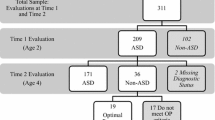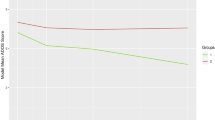Abstract
We examined whether exiting high school was associated with alterations in rates of change in autism symptoms and maladaptive behaviors. Participants were 242 youth with ASD who had recently exited the school system and were part of our larger longitudinal study; data were collected at five time points over nearly 10 years. Results indicated overall improvement of autism symptoms and internalized behaviors over the study period, but slowing rates of improvement after exit. Youth who did not have an intellectual disability evidenced the greatest slowing in improvement. Lower family income was associated with less improvement. Our findings suggest that adult day activities may not be as intellectually stimulating as educational activities in school, reflected by less phenotypic improvement after exit.


Similar content being viewed by others

References
Aman, M. G., Lam, K. S. L., & Collier-Crespin, A. (2003). Prevalence and patterns of use of psychoactive medicines among individuals with autism in the Autism Society of Ohio. Journal of Autism and Developmental Disorders, 33, 527–534.
Benson, P. R. (2006). The impact of child symptom severity on depressed mood among parents of children with ASD: The mediating role of stress proliferation. Journal of Autism and Developmental Disorders, 36, 685–695.
Billstedt, E., Gillberg, I. C., & Gillberg, C. (2007). Autism in adults: Symptom patterns and early childhood predictors. Use of the DISCO in a community sample followed since childhood. Journal of Child Psychology and Psychiatry, 48, 1102–1110.
Bouma, R., & Schweitzer, R. (1990). The impact of chronic childhood illness of family stress: A comparison between autism and cystic fibrosis. Journal of Clinical Psychology, 46, 722–730.
Bruininks, R. H., Woodcock, R. W., Weatherman, R. F., & Hill, B. K. (1996). Scales of independent behavior revised. Rolling Meadows, IL: Riverside Publishing.
Bryk, A. S., & Raudenbush, S. W. (1987). Application of hierarchical linear models to assessing change. Psychological Bulletin, 101, 147–158.
Bryson, S. E., & Smith, I. M. (1998). Epidemiology of autism: Prevalence, associated characteristics, and implications for research and service delivery. Mental Retardation and Developmental Disabilities Research Reviews, 4, 97–103.
Donovan, A. M. (1988). Family stress and ways of coping with adolescents who have handicaps: Maternal perceptions. American Journal on Mental Retardation, 92, 502–509.
Dumas, J. E., Wolf, L. C., Fisman, S. N., & Culligan, A. (1991). Parenting stress, child behavior problems, and dysphoria in parents of children with autism, Down syndrome, behavior disorders, and normal development. Exceptionality, 2, 97–110.
Eaves, L. C., & Ho, H. H. (2008). Young adult outcomes of autism spectrum disorders. Journal of Autism and Developmental Disorders, 38, 739–747.
Esbensen, A. J., Seltzer, M. M., & Krauss, M. W. (2008). Stability and change in health, functional abilities, and behavior problems among adults with and without Down syndrome. American Journal on Mental Retardation, 113, 263–277.
Fecteau, S., Mottron, L., Berthiaume, C., & Burack, J. A. (2003). Developmental changes of autistic symptoms. Autism, 7, 255–268.
Fombonne, E. (2003). Epidemiological surveys of autism and other pervasive developmental disorders: An update. Journal of Autism and Developmental Disorders, 33, 365–382.
Francis, D. J., Fletcher, J. M., Stuebing, K. K., Davidson, K. C., & Thompson, N. M. (1991). Analysis of change: Modeling individual growth. Journal of Consulting and Clinical Psychology, 59, 27–37.
Galambos, N. L., Barker, E. T., & Krahn, H. J. (2006). Depression, self-esteem, and anger in emerging adulthood: Seven-year trajectories. Developmental Psychology, 42, 350–365.
Gillberg, C., & Steffenburg, S. (1987). Outcome and prognostic factors in infantile autism and similar conditions: A population-based study of 46 cases followed through puberty. Journal of Autism and Developmental Disorders, 17, 273–287.
Glutting, J. J., Adams, W., & Sheslow, D. (2000). Wide range intelligence test. Wilmington, DE: Wide Range.
Gurney, J. G., Fritz, M. S., Ness, K. K., Sievers, P., Newschaffer, C. J., & Shapiro, E. G. (2003). Analysis of prevalence trends of autism spectrum disorder in Minnesota. Archives of Pediatrics and Adolescent Medicine, 157, 622–627.
Hastings, R. P. (2003). Child behaviour problems and partner mental health as correlates of stress in mothers and fathers of children with autism. Journal of Intellectual Disability Research, 47, 231–237.
Hastings, R. P., & Brown, T. (2002). Behavior problems of children with autism, parental self-efficacy, and mental health. American Journal on Mental Retardation, 107, 222–232.
Hill, A., Bolte, S., Petrova, G., Beltcheva, D., Tacheva, S., & Poustka, F. (2001). Stability and interpersonal agreement of the interview based diagnosis of autism. Psychopathology, 34, 187–191.
Hollander, E., Phillips, A. T., & Yeh, C. C. (2003). Targeted treatments for symptom domains in child and adolescent autism. Lancet, 362, 732–734.
Holroyd, J., & McArthur, D. (1976). Mental retardation and stress on the parents: A contrast between Down’s syndrome and childhood autism. American Journal on Mental Deficiency, 80, 431–436.
Howlin, P. (2005). Outcomes in autism spectrum disorders. In F. R. Volkmar, R. Paul, A. Klin, & D. Cohen (Eds.), Handbook of autism and pervasive developmental disorders, vol. 1: Diagnosis, development, neurobiology, and behavior (3rd ed., pp. 201–220). Hoboken, NJ: Wiley.
Howlin, P., Alcock, J., & Burkin, C. (2005). An 8 year follow-up of a specialist supported employment service for high-ability adults with autism or Asperger syndrome. Autism, 9, 533–549.
Howlin, P., Goode, S., Hutton, J., & Rutter, M. (2004). Adult outcome for children with autism. Journal of Child Psychology and Psychiatry, 45, 212–229.
Howlin, P., Mawhood, L., & Rutter, M. (2000). Autism and developmental receptive language disorder A follow-up comparison in early adult. II: Social, behavioural, and psychiatric outcomes. Journal of Child Psychology and Psychiatry and Allied Disciplines, 41, 561–578.
Lecavalier, L. (2006). Behavioral and emotional problems in young people with pervasive developmental disorders: Relative prevalence, effects of subject characteristics, and empirical classification. Journal of Autism and Developmental Disorders, 36, 1101–1114.
Lecavalier, L., Leone, S., & Wiltz, J. (2006). The impact of behaviour problems on caregiving stress in young people with autism spectrum disorders. Journal of Intellectual Disability Research, 50, 172–183.
Liptak, G. S., Benzoni, L. B., Mruzek, D. W., Nolan, K. W., Thingvoll, M. A., Wade, C. M., et al. (2008). Disparities in diagnosis and access to health services for children with autism: Data from the national survey of children’s health. Journal of Developmental and Behavioral Pediatrics, 29, 152–160.
Lord, C., & Bailey, A. (2002). Autism spectrum disorders. In M. Rutter & E. Taylor (Eds.), Child and adolescent psychiatry (pp. 664–681). Oxford: Blackwell Scientific.
Lord, C., Pickles, A., McLennan, J., Rutter, M., Bregman, J., Folstein, S., et al. (1997). Diagnosing autism: Analyses of data from the autism diagnostic interview. Journal of Autism and Developmental Disorders, 27, 501–517.
Lord, C., Rutter, M., & Le Couteur, A. (1994). Autism diagnostic interview-revised: A revised version of a diagnostic interview for caregivers of individuals with possible pervasive developmental disorders. Journal of Autism and Developmental Disorders, 24, 659–685.
Lounds, J., Seltzer, M. M., Greenberg, J. S., & Shattuck, P. T. (2007). Transition and change in adolescents and young adults with autism: Longitudinal effects on maternal well-being. American Journal on Mental Retardation, 112, 401–417.
Luckasson, R., Borthwick-Duffy, S., Buntinx, W. H. E., Coulter, D. L., Craig, E. M., Reeve, A., et al. (2002). Mental retardation: Definition, classification, and systems of supports (10th ed.). Washington, DC: American Association on Mental Retardation.
Marmot, M., Ryff, C. D., Bumpass, L. L., Shipley, M., & Marks, N. F. (1997). Social inequalities in health: Next questions and converging evidence. Social Science and Medicine, 44, 901–910.
Mawhood, L., Howlin, P., & Rutter, M. (2000). Autism and developmental receptive language disorder—a comparative follow-up in early adult life. I: Cognitive and language outcomes. Journal of Child Psychology and Psychiatry and Allied Disciplines, 41, 547–559.
McGovern, C. W., & Sigman, M. (2005). Continuity and change from early childhood to adolescence in autism. Journal of Child Psychology and Psychiatry, 46(4), 401–408.
Piven, J., Harper, J., Palmer, P., & Arndt, S. (1996). Course of behavioral change in autism: A retrospective study of high-IQ adolescents and adults. Journal of the Academy of Child and Adolescent Psychiatry, 35, 523–529.
Raudenbush, S. W., & Bryk, A. S. (2002). Hierarchical linear models: Applications and data analysis methods (2nd ed.). Thousand Oaks, CA: Sage.
Rodrigue, J. R., Morgan, S. B., & Geffken, G. R. (1990). Families of autistic children: Psychological functioning of mothers. Journal of Clinical Psychology, 19, 371–379.
Ryff, C. D., & Singer, B. H. (2008). Know thyself and become what you are: A eudaimonic approach to psychological well-being. Journal of Happiness Studies, 9, 13–39.
Seltzer, M. M., Krauss, M. W., Shattuck, P. T., Orsmond, G., Swe, A., & Lord, C. (2003). The symptoms of autism spectrum disorders in adolescence and adulthood. Journal of Autism and Developmental Disorders, 33, 565–581.
Shattuck, P. T., Seltzer, M. M., Greenberg, J. S., Orsmond, G. I., Kring, S., Bolt, D., et al. (2007). Changes in autism symptoms and maladaptive behaviors among adolescents and adults with an autism spectrum disorder. Journal of Autism and Developmental Disorders, 37, 1735–1747.
Shea, S., Turgay, A., Carroll, A., Schulz, M., Orlik, H., Smith, I., et al. (2004). Risperidone in the treatment of disruptive behavioral symptoms in children with autistic and other pervasive developmental disorders. Pediatrics, 114, 634–641.
Shea, V., & Mesibov, G. B. (2005). Adolescents and adults with autism. In F. R. Volkmar, R. Paul, A. Klin, & D. J. Cohen (Eds.), Handbook of autism and pervasive developmental disorders, vol. 1: Diagnosis, development, neurobiology, and behavior (3rd ed., pp. 288–311). Hoboken, NJ: Wiley.
Shepperdson, B. (1995). Two longitudinal studies of the abilities of people with Down’s syndrome. Journal of Intellectual Disability Research, 39, 419–431.
Singer, J. D., & Willett, J. B. (2003). Applied longitudinal data analysis: Modeling change and event occurrence. Oxford, England: Oxford University Press.
Sparrow, S. S., Carter, A. S., & Cicchetti, D. V. (1993). Vineland screener: Overview, reliability, validity, administration, and scoring. New Haven: Yale University Child Study Center.
Taylor, J. L. (2009). The transition out of high school and into adulthood for individuals with autism and for their families. International Review of Research in Mental Retardation, 38, 1–32.
Taylor, J. L., & Seltzer, M. M. (2010). The transition to adulthood for individuals with ASD and their families. In P. Howlin (Chair), What really matters: Measuring outcome and addressing the needs of adolescents and adults with ASD. Invited Educational Symposium conducted at the International Meetings for Autism Research, Philadelphia, PA.
Thomas, K. C., Ellis, A. R., McLaurin, C., Daniels, J., & Morrissey, J. P. (2007). Access to care for autism-related services. Journal of Autism and Developmental Disorders, 37, 1902–1912.
Tobing, L. E., & Glenwick, D. S. (2002). Relation of the childhood autism rating scale-parent version to diagnosis, stress, and age. Research in Developmental Disabilities, 23, 211–223.
Tomanik, S., Harris, G. E., & Hawkins, J. (2004). The relationship between behaviours exhibited by children with autism and maternal stress. Journal of Intellectual and Developmental Disability, 29, 16–26.
Tonge, B. J., & Einfeld, S. (2003). Psychopathology and intellectual disability: The Australian child to adult longitudinal study. International Review of Research in Mental Retardation, 26, 61–91.
Wheaton, B., & Gotlib, I. H. (1997). Trajectories and turning points over the life course: Concepts and themes. In I. H. Gotlib & B. Wheaton (Eds.), Stress and adversity over the life course: Trajectories and turning points (pp. 1–28). UK: Cambridge Press.
Wolf, L. C., Noh, S., Fisman, S. N., & Speechley, M. (1989). Psychological effects of parenting stress on parents of autistic children. Journal of Autism and Developmental Disorders, 19, 157–166.
Acknowledgments
This project was supported by the Marino Autism Research Institute (J. L. Taylor, PI), the National Institute on Aging (R01 AG08768, M. M. Seltzer, PI) and the Eunice Kennedy Shriver National Institute of Child Health and Human Development (P30 HD15052, E. M. Dykens, PI: P30 HD03352, M. M. Seltzer PI). We are grateful to Erin Barker for statistical consultation and Dan Bolt for his comments on an earlier version of this manuscript.
Author information
Authors and Affiliations
Corresponding author
Rights and permissions
About this article
Cite this article
Taylor, J.L., Seltzer, M.M. Changes in the Autism Behavioral Phenotype During the Transition to Adulthood. J Autism Dev Disord 40, 1431–1446 (2010). https://doi.org/10.1007/s10803-010-1005-z
Published:
Issue Date:
DOI: https://doi.org/10.1007/s10803-010-1005-z



